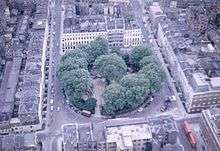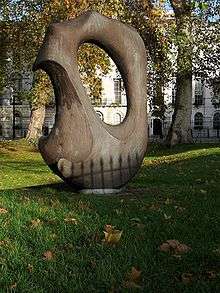Fitzroy Square


Fitzroy Square is one of the Georgian squares in London and is the only one found in the central London area known as Fitzrovia.
History
The square, nearby Fitzroy Street, and the Fitzroy Tavern in Charlotte Street have the family name of Charles FitzRoy, 2nd Duke of Grafton, into whose ownership the land passed through his marriage.[1] His descendant Charles FitzRoy, 1st Baron Southampton developed the area during the late 18th and early 19th century.
Fitzroy Square was a speculative development intended to provide London residences for aristocratic families, and was built in four stages. Leases for the eastern and southern sides, designed by Robert Adam, were granted in 1792; building began in 1794[2] and was completed in 1798 by Adam's brothers James and William. These buildings are fronted in Portland stone brought by sea from Dorset.
The Napoleonic Wars and a slump in the London property market brought a temporary stop to construction of the square after the south and east sides were completed. According to the records of the Squares Frontagers' Committee, 1815 residents looked out on "vacant ground, the resort of the idle and profligate". Another contemporary account describes the incomplete square:
"The houses are faced with stone, and have a greater proportion of architectural excellence and embellishment than most others in the metropolis. They were designed by the Adams, but the progress of the late war prevented the completion of the design. It is much to be regretted, that it remains in its present unfinished state."[3]
The northern and western sides were subsequently constructed in 1827–29 and 1832–35 respectively, and are stucco-fronted.[2]
The south side suffered bomb damage during World War II and was rebuilt with traditional facades to remain in keeping with the rest of the square.
Present day
The square was largely pedestrianised in the 1970s, as part of a scheme designed by Sir Geoffrey Jellicoe and undertaken as part of environmental improvement works.[4][5] In 2008 the square was upgraded by relaying most of the surface at a single level, removing street clutter such as bollards, and further restricting vehicular access.[6]
The Square is at the heart of the Fitzrovia conservation area, and the subject of the Fitzroy Square conservation area appraisal and management strategy adopted by the London Borough of Camden in March 2010.[7]
Notable buildings
The square has a number of notable buildings, many with distinguished connections marked by blue plaques.
Numbers 1, 1A, 2–8 and 33–40 are grade I listed buildings.
- No. 6 holds the office and library of the Georgian Group.
- No. 7 was the home of Sir Charles Eastlake, first director of the National Gallery.
- No. 8 was the home of the painter James McNeill Whistler.
- No. 9 was the home of chemist August Wilhelm von Hofmann (1818–1892).
- No. 11 for varying lengths of time housed the offices of publishers Cresset Press, Merlin Press and Allison and Busby.[8]
- No. 13–14 was home to St Luke's Hospital for the Clergy (1904–2009).
- No. 19 was the base for the "International School" run by Louise Michel in the 1890s.[9] Later it was the home of Bloomsbury Group artist Duncan Grant (c. 1909).[10]
- No. 21 was the home of English statesman and Prime Minister Lord Salisbury. It is now occupied by the High Commission of Mozambique.
- No. 23 is the Embassy of Liberia.
- No. 27 was the home of theatre critic and occasional Shaw collaborator William Archer.[11]
- No. 28 is the headquarters of the Magistrates' Association.
- No. 29 was the home of George Bernard Shaw from 1887 until his marriage in 1898; and later of Virginia Woolf from 1907 to 1911.
- No. 33 housed Roger Fry's Omega Workshop, creating avant-garde furniture from 1913 to 1919.[12]
- No. 34–35, owned by Guy Ritchie, was controversially squatted as the London Free School in 2011.
- No. 37 was the home of the artist Sir William Quiller Orchardson from 1862, an address he shared for three years with John Pettie. Later it was the home of the artist Ford Madox Brown and childhood home of his grandson, the writer Ford Madox Ford.
Notable residents

In addition to those above:
- General Francisco de Miranda lived at nearby 58 Grafton Way (1802–10). On the corner of 40 Fitzroy Square is a commemorative statue.[13]
- Epidemiologist William Farr (1807–1883) established his first medical practice in Fitzroy Square.
- William Nisbet (1759–1822) - Scottish physician and medical writer practised in Fitzroy Square after 1801.
- Spandau Ballet's Gary Kemp currently lives here
Culture and media
The square is described in William Makepeace Thackeray's Vanity Fair as the "Anglo-Indian district", where many retired officials of the civil service in India resided.
It was a filming location for the BBC's 2009 adaptation of Jane Austen's novel Emma.[14]
C. R. W. Nevinson painted a view of Fitzroy Square from the window of society hostess Mrs Aria, evidently looking east from the Conway Street corner of the square.[15][16]
On the south-west side of the square's central gardens is a bronze sculpture created by Naomi Blake to commemorate Queen Elizabeth II’s Silver Jubilee in 1977.
Until April 2011, No. 11 was the long-term home of author Ian McEwan, who set much of his 2005 novel Saturday, and the home of its leading character, brain surgeon Henry Perowne, in the square.
Novelist Jacqueline Winspear gives her 1920s detective Maisie Dobbs an office in Fitzroy Square.[17]
The TARDIS stands in Fitzroy Square for the duration of the 1966 Doctor Who series The War Machines.
The Monty Python team held a writing office at number 20 between 1973 and 1974.[18]
See also
References
- ↑ Tottenham Court Road in Old and New London: Volume 4 (1878), pp. 467–480, from British History Online
- 1 2 10 Fitzroy Square Archived May 14, 2007, at the Wayback Machine.
- ↑ Leigh's New Picture of London. Printed for Samuel Leigh, 18, Strand; by W. Clowes, Northumberland Court. 1819
- ↑ "Fitzroy Square Garden". Gardenvisit.com. Retrieved 19 January 2014.
- ↑ "Fitzroy Square Conservation Area Appraisal and Management Strategy (March 2010), s.3.19". London Borough of Camden. Retrieved 23 December 2013.
- ↑ "Historic Fitzroy Square goes back to the future - photos", Camden.gov.uk.
- ↑ "Fitzroy Square conservation area appraisal and management strategy — Camden Council". Camden.gov.uk. Retrieved 19 January 2014.
- ↑ "Margaret Busby Remembers Clive Allison", Poetry Book Society, 5 August 2011.
- ↑ Mike Pentelow (31 March 2011). "The anarchist school in Fitzroy Square". Fitzrovia News. Retrieved 19 January 2014.
- ↑ Books and Writers — Bloomsbury Group
- ↑ Raymond Biswanger Slide Collection.
- ↑ Omega Archived October 16, 2007, at the Wayback Machine.
- ↑ "General Francisco de Miranda | Flickr - Photo Sharing!". Flickr. 1 March 2010. Retrieved 19 January 2014.
- ↑ "Emma (2009 TV Mini-Series)|Filming Locations", IMDb.
- ↑ Mrs Aria, My Sentimental Self, Chapman & Hall, 1922, pp. 241–242.
- ↑ "'Fitzroy Square', Christopher Richard Wynne Nevinson". Tate. 1 May 1958. Retrieved 19 January 2014.
- ↑ www.xuni.com. "Author Jacqueline Winspear". Jacquelinewinspear.com. Retrieved 19 January 2014.
- ↑ Terry Jones; Terry Gilliam; Michael Palin; John Cleese; Graham Chapman (December 1992). Monty Python and the Holy Grail (BOOK!). Methuen. p. 42. ISBN 0749311428.
External links
Coordinates: 51°31′22.61″N 00°08′24.37″W / 51.5229472°N 0.1401028°W